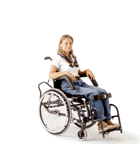Hazards and Solutions
Introduction
Providing care to nursing home residents is physically demanding work. Nursing home residents often require assistance to walk, bathe, or perform other normal daily activities. In some cases, residents are totally dependent upon caregivers for mobility. Manual lifting and repositioning residents increase the risk of pain and injury to caregivers, particularly to the back.
These tasks require high physical demands due to factors such as:
- the heavy weight of patients;
- awkward postures when leaning over a bed or working in a confined area; and
- shifting weight that may occur if a resident loses balance or strength while moving
Risk Factors

Given the increasingly hazardous biomechanical demands on caregivers today, it is clear the healthcare industry must rely on technology to make patient handling and movement safe.
- Force - the amount of physical effort required to perform a task (such as heavy lifting) or to maintain control of equipment or tools.
The ergonomic risk factors that workers in nursing homes face include:
- Repetition - performing the same motion or series of motions continually or frequently.
- Awkward postures - assuming positions that place stress on the body, such as reaching above shoulder height, kneeling, squatting, leaning over a bed, or twisting the torso while lifting.
Knowledge Check Choose the best answer for the question.
2-1. Which term is defined as the amount of physical effort required to perform a task or maintain control of equipment or tools?
You forgot to answer the question!
